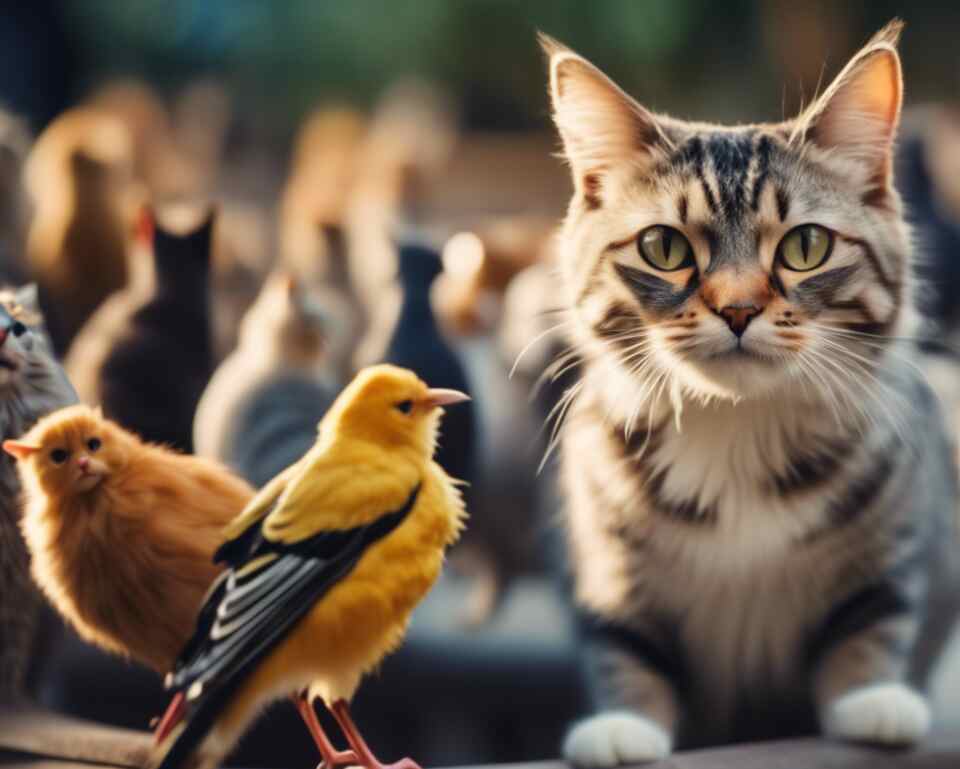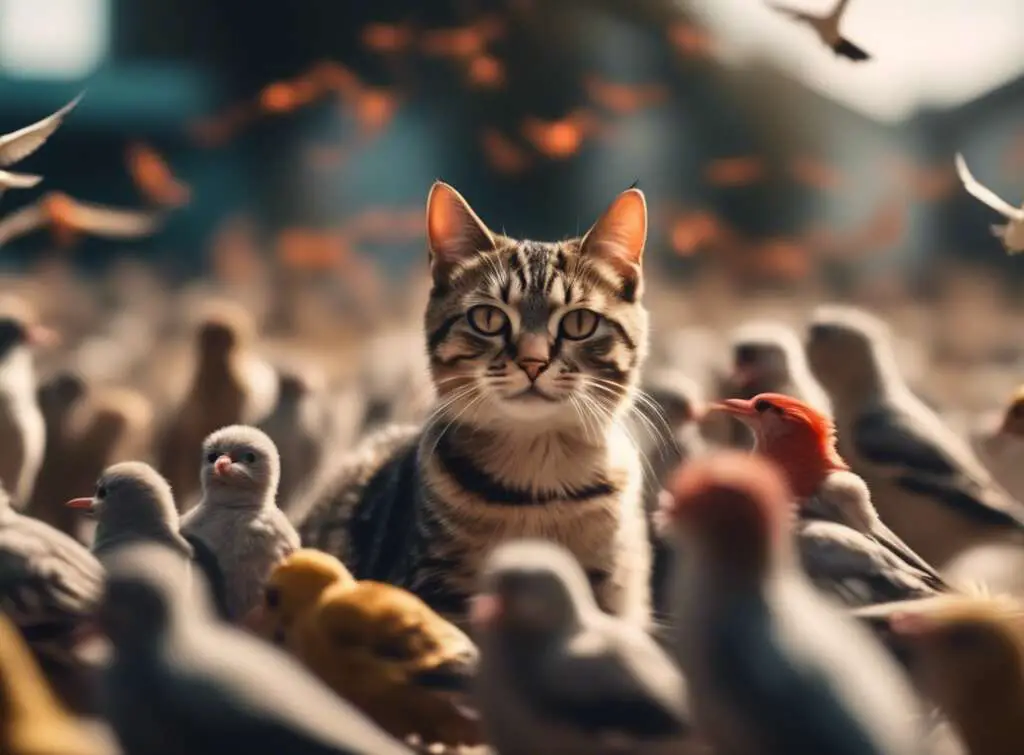Feral and domestic cats have long been a source of concern when it comes to their impact on bird populations worldwide. These predators have the instinct to hunt small animals, which includes birds. The question of “how many birds are killed by cats in the world” has been a subject of research and debate among scientists, conservationists, and animal lovers alike.
Table of Contents
The Global Impact of Feral and Domestic Cats on Bird Populations
Understanding the Extent of Bird Mortality
Cats, both feral and domestic, pose a significant threat to bird populations worldwide. Studies reveal that cats kill an estimated 2.4 billion birds each year in the United States alone, and about 200 million annually in Canada. Globally, cats are responsible for billions of bird deaths each year. Feral cats account for about 70% of these deaths, while owned, outdoor cats are responsible for the remaining 30%. In Australia, cats kill approximately 377 million birds annually, and in the United Kingdom, the estimate stands at 27 million bird deaths per year.
Ground-nesting birds and island species are particularly vulnerable, with cats contributing to the extinction of 63 bird species of birds in some areas. This impact is exacerbated by habitat loss, climate change, and pesticide use, highlighting the need for responsible pet ownership and conservation efforts to protect vulnerable bird species.
The Hunting Instinct of Cats
Cats are natural hunters, with instincts that drive them to stalk, pounce, and capture prey. Even well-fed domestic cats retain their hunting instincts. Feral cats, on the other hand, rely on hunting for survival. This predatory behavior poses a serious threat to bird populations, especially those that nest on the ground or in low shrubbery.
Vulnerable Bird Species at Risk
Certain bird species are more vulnerable to cat predation than others. Ground-nesting birds, such as quails, plovers, and some songbirds, face a higher risk of being targeted by cats. Birds that are inexperienced in dealing with predators or those that are slow-moving are also at greater risk of falling prey to cats.
Impact on Ecosystems
The uncontrolled predation of birds by cats can have far-reaching consequences on ecosystems. Birds play a crucial role in various ecological processes, such as pollination, seed dispersal, and insect control. A decline in bird populations can disrupt these processes, leading to imbalances within ecosystems.
Addressing the Issue
Efforts to mitigate the impact of cats on bird populations include responsible pet ownership, spaying and neutering feral cats to prevent their population growth, and implementing trap-neuter-return programs for feral cat colonies. Keeping cats indoors, especially during peak bird migration seasons, can also help reduce bird mortality.
The question of “how many birds are killed by cats in the world” underscores the importance of understanding and addressing the impact of cat predation on bird populations. By raising awareness, implementing practical solutions, and promoting coexistence between cats and birds, we can work towards preserving biodiversity and ensuring the survival of avian species for generations to come.

Strategies to Mitigate Bird Deaths Caused by Cats
Implementing Effective Strategies to Protect Birds
Birds are an essential part of our ecosystem, contributing to pollination, seed dispersal, and insect control. However, the predation of birds by domestic and feral cats poses a severe threat to bird populations worldwide. Studies estimate that cats are responsible for the deaths of millions, if not billions, of birds each year. To mitigate these losses and protect our feathered friends, it is crucial to implement effective strategies to reduce the impact of cats on bird populations.
Promoting Responsible Pet Ownership
One of the most critical steps in mitigating bird deaths caused by cats is promoting responsible pet ownership. Cat owners can play a significant role in protecting birds by keeping their pets indoors, especially during peak bird migration seasons. Providing cats with enriching indoor environments, such as climbing trees, scratching posts, and interactive toys, can help satisfy their natural hunting instincts without endangering bird populations.
Supporting Trap-Neuter-Return Programs
Trap-Neuter-Return (TNR) programs are an effective way to manage feral cat populations and reduce their impact on birds. By trapping feral cats, neutering or spaying them, and then returning them to their original locations, TNR programs help prevent the birth of new feral kittens while allowing existing cats to live out their lives without reproducing. This humane approach not only controls the feral cat population but also minimizes their predatory impact on birds.
Encouraging the Use of Catios
Catios, also known as outdoor cat enclosures or cat patios, provide a safe and controlled outdoor space for cats to enjoy the sights, sounds, and smells of the outdoors without posing a threat to birds and other wildlife. By constructing or purchasing a catio, cat owners can give their feline companions the opportunity to experience the outdoors while protecting local bird populations from predation.
Collaborating with Conservation Organizations
Collaborating with local and national conservation organizations can help raise awareness about the impact of cats on bird populations and promote bird-friendly practices in communities. By partnering with conservation groups, pet owners, animal shelters, and local authorities can work together to implement bird-safe practices, such as advocating for bird-friendly landscaping, supporting bird conservation initiatives, and educating the public about the importance of protecting birds from cat predation.
Mitigating bird deaths caused by cats requires a multi-faceted approach that involves promoting responsible pet ownership, supporting Trap-Neuter-Return programs, encouraging the use of catios, and collaborating with conservation organizations. By implementing these strategies and working together as a community, we can help protect birds from the threats posed by cats and ensure a safer environment for both our feline companions and our feathered friends.
Conclusion
In light of the global impact that feral and domestic cats have on bird populations, it is evident that these feline predators pose a significant threat to the avian species worldwide. With millions of birds falling victim to cat predation each year, it is crucial for communities, conservationists, and pet owners to work together to implement strategies that can help mitigate bird deaths caused by cats.
One of the key strategies in reducing bird deaths by cats is responsible pet ownership. By keeping cats indoors, pet owners can significantly decrease the number of birds that fall prey to their feline companions. Providing cats with stimulating indoor environments, such as cat trees, toys, and interactive play sessions, can help satisfy their natural instincts while keeping them from hunting birds.
Another effective approach is the implementation of TNR (Trap-Neuter-Return) programs for feral cat populations. By neutering and vaccinating feral cats before releasing them back into their environment, these programs help stabilize cat populations and reduce the impact of feral cats on bird populations. Furthermore, providing supplementary feeding for feral cat colonies can help reduce their hunting pressure on local bird species.
Communities can also play a vital role in protecting birds from cat predation by creating bird-friendly environments. Planting native vegetation, installing bird feeders at safe heights, and using deterrents such as collars with bells on outdoor cats can help reduce bird deaths significantly. Additionally, educating the public about the importance of protecting bird populations and raising awareness about the impact of free-roaming cats can foster a culture of bird conservation.
Conservation organizations and policymakers should collaborate to implement laws and regulations that promote responsible pet ownership and feral cat management. By enacting and enforcing laws that require cats to be kept indoors or on leashes when outdoors, governments can help safeguard bird populations and protect the delicate balance of ecosystems. Investing in research to better understand the interactions between cats and birds can also inform the development of evidence-based conservation strategies.
The relationship between cats and birds is a complex issue that requires a multifaceted approach to address. By raising awareness, promoting responsible pet ownership, and implementing targeted strategies, we can work together to mitigate bird deaths caused by cats and preserve the diversity of avian species around the world. It is up to each one of us to take action and make a positive impact on the coexistence of cats and birds in our shared environment.
Only through collective efforts can we ensure a harmonious balance between these two essential components of our natural world.


